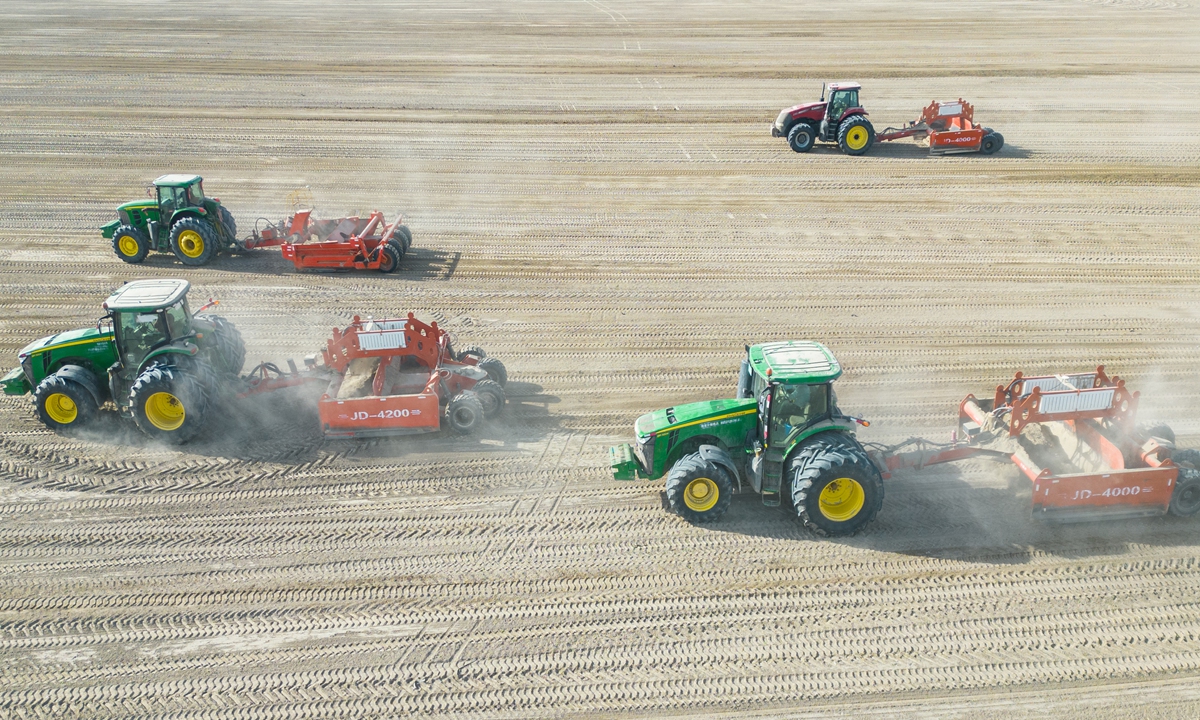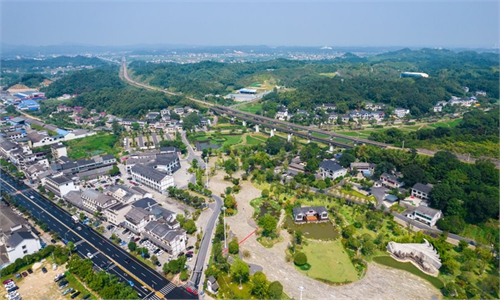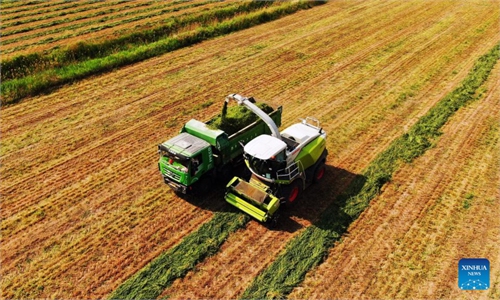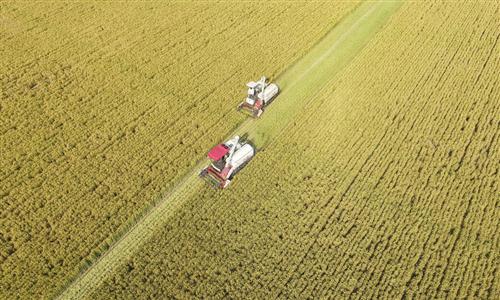Detailed measures expected to support No.1 document roll-out
Aims to tackle food security, advance rural vitalization

Farming machines level the ground for the creation of high-standard farmland in Yuli county, Northwest China's Xinjiang Uygur Autonomous Region on December 7, 2023. The area of China's high-standard farmland will total 1.2 billion mu (about 80 million hectares) by 2030, according to Ministry of Agriculture and Rural Affairs. Photo: VCG
Chinese officials on Sunday outlined plans for detailed implementation targeting the policy measures deployed by the "No.1 central document," which was released by the Communist Party of China (CPC) Central Committee and the State Council, the cabinet, on Saturday, covering major tasks from ensuring food security to bolstering rural industries.
Experts noted that the targeted measures will play a vital role in facilitating the implementation of the tasks, while the document emphasizes that China's top leadership attaches great significance to the country's agricultural modernization, rural vitalization and farmers' livelihoods.
When it comes to consolidating China's efforts in stabilizing food production and safeguarding food security, Zhu Weidong, a deputy director of the office of the Central Financial and Economic Affairs Commission, outlined four effective measures - stabilizing sowing areas, improving yields per unit, expanding food resources and strengthening food savings.
In 2023, China's grain output reached a record high of 1.39 trillion jin (695.41 million tons), and sufficient food supply and stockpiles provide strong support for the continuous economic recovery, Zhu said at a press conference.
The document called for maintaining grain output of more than 1.3 trillion jin in 2024.
Han Wenxiu, an executive deputy director of the Office of the Central Financial and Economic Affairs Commission, said that major measures such as enhancing support for major grain-producing counties in China, establishing a compensation mechanism and extending the industry chain will be implemented to mobilize the production enthusiasm of farmers in China's major food-producing regions.
China prioritizes stabilizing and enhancing production capacity when it comes to ensuring food security, with a focus on stabilizing sowing areas while utilizing technology and technological applications to elevate the yield level per unit, Li Guoxiang, a research fellow at the Rural Development Institute of the Chinese Academy of Social Sciences, told the Global Times on Sunday.
This year's document made a systemic deployment of strengthening the dual effect of science and technology and reform, with a focus on synergistically promoting scientific and technological innovation and institutional innovation to inject vitality into advancing rural vitalization, an official from the office of the Central Rural Work Leading Group said in an interview with the Xinhua News Agency on Saturday.
Li highlighted the top-down cooperation of the administrative system and reasonable prices to ensure farmers' interests as two key factors in tackling the stabilization of sowing areas.
In terms of stabilizing yields per unit for key crops such as soybean and corn, Li noted that there is huge potential in elevating yields per unit, which remain at relatively low levels.
Li outlined measures such as selecting high-yield varieties, increasing the density of planting and other technical means.
The scarcity of domestic oilseeds is a major reason for soybeans being the largest imported crop in China, and the responsible authorities have stepped up policy support to increase the sowing area for soybeans, Zheng Fengtian, a professor at Renmin University of China's School of Agricultural Economics and Rural Development, told the Global Times on Sunday, adding that the current sowing area remains at a relatively good level of about 150 million mu (10 million hectares).
In addition to elevating yields and optimizing the major grains, saving food will also be an important means to ensure food security, as the amount of food waste is still huge, Zheng said.
Boosting rural industries remains as another focus highlighted at the press conference, as the prosperity of rural industries is the premise of rural vitalization.
Zhu detailed four corresponding measures: highlighting local characteristics, focusing on industrial integration, enhancing the processing of agricultural products and smoothing rural logistics.
Li stressed the importance for domestic rural areas to further progress the industrial system catering to local advantages and resources by cooperating with diverse means such as e-commerce and green industries, as developing local industries mainly relies on the market while elevating competitiveness.
The "No.1 central document" is the first policy statement the central government releases at the beginning of each year, which focuses on agricultural and rural issues.
This year is the 12th "No.1 central document" on agricultural and rural work since the 18th National Congress of the CPC in 2012, according to the Xinhua News Agency.
The 2024 document contains 28 specific policy measures in six main areas, including ensuring national food security, which outlines the priorities for comprehensively promoting rural vitalization this year.



